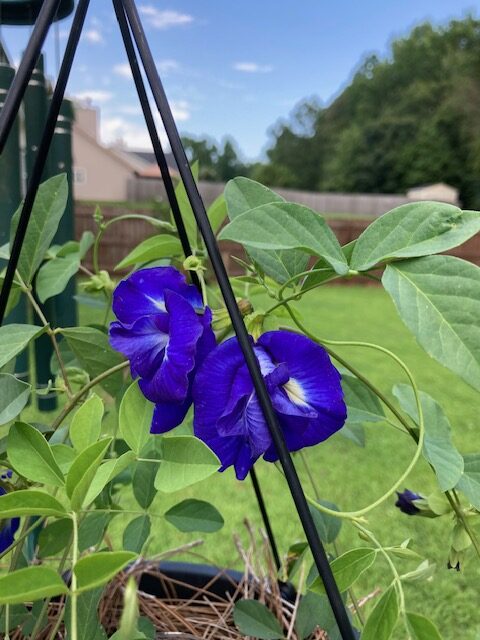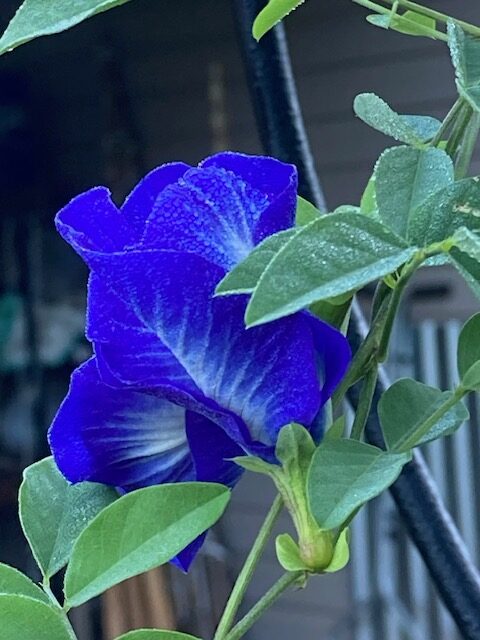
Butterfly Pea
Whether growing over a trellis or cascading out of a hanging basket, the butterfly pea is a gorgeous, edible flower stunning in any garden. The heat-loving butterfly pea is grown for its flowers, which are a natural food dye and can be steeped for tea!
|
Blue Queen |
|
Clitoria ternatea |
|
Difficult then Easy |
|
Easy |
|
3-4 years if properly stored (best guess) |
|
Annual USDA zones 10-warmer are Perennial |
|
15-20 days |
|
70-75 F |
|
No |
|
No |
|
Vine |
|
Full sun to part shade |
|
Summer-Fall |
|
April, May |
|
Yes |

My Blue Queen Butterfly Pea. Grown in a hanging basket. Picture by Elizabeth Jones
Table of Contents
Growing Tips




When to Start
Spring: Start indoors 8-10 weeks before the last frost and the soil has warmed up to 70-75 F. (End of March/Beginning of April for GA)
Direct Sow: Only in USDA zones 9 or warmer.
Transplant: After ALL danger of frost has passed and the soil has warmed up to 70-75 F. (End of May for GA)
How to Grow
Scarify the seeds by using a nail file to gently scratch the seed and soak them for 24 hours before sowing to aid germination. For all zones colder than 9, start the seeds indoors 8-10 weeks before transplanting. (End of March/Beginning of April for GA.) Sow in seed cells to a depth of 1/2 inch and place on a heat mat. Butterfly pea germinates best at a temperature of 70-75 F.
The seeds can be slow to germinate and the hard waxy shell makes it challenging for the seeds to soak up the water necessary for germination. So germination can be low. This is why it is important to scarify and soak the seeds before planting. Harden off the seedlings and transplant them into a full sun bed with a trellis or hanging basket. Space plants 3-4” apart.
Seeds may need help from soil inoculation to germinate. See my personal experience about using outside garden soil for another way to help germination.
Care
The butterfly pea is a heat-loving plant. It loves temperatures from 78-100 F. It likes well-draining soil and will tolerate most soil types with one exception. It likes consistently moist soil but hates soggy feet. In any areas that have clay, pooling water, or soils that simply don’t drain well, add organic matter to improve the soil structure to make the soil loamier. Or grow in a container and place it near a trellis for it to climb. When using a hanging basket or container, mulch and try a water bottle reservoir to keep the soil consistently moist in between watering and during the hot days of summer.
This flower is in the legume family and as such enriches the soil by fixing nitrogen in it. It can be used as a cover crop or living mulch. Butterfly peas are also useful in crop rotation. By planting them where heavy feeders have grown (pumpkins and squashes) they will replenish the soil. Other than keeping the soil moist but not soggy, maintenance is very low.
Harvest
Harvest the flowers throughout the growing season. Flowers are short-lived and only bloom for about 1 day. Pick flowers once they have bloomed or wait until they have shriveled. By waiting the seed pod will have started to form and the flower will be partially dehydrated and easily pull away. Either way, place the removed flowers on plastic plates (they might stick to paper) and place them in a well-ventilated area out of direct sunlight. Allow to fully dry, like you would herbs, and store in an airtight jar.
Culinary Uses
Dried blossoms can be steeped in hot water to make a stunningly vibrant, blue tea. The flavor is bland, which makes the butterfly pea a great natural dye, and is used in Asian cuisine to dye rice and desserts. By adding some lemon to the tea, it turns a beautiful shade of pink. It can be used to make a natural pink lemonade. It also is reported to have many health benefits due to its antioxidants and minerals.
My personal experience
I started 2 different batches both with 6 seeds. I nicked and soaked, then planted the first 6 seeds in a sterile mix. Only 1 of 6 germinated and it took forever (the max number of days for germination or just beyond 20-25 days).
The second time I nicked and soaked 6 seeds and I used outside dirt from my garden. I read where butterfly peas might need the aid of a soil fungus and bacterium to help them germinate. (See tips and tricks for more details.) Three of the 6 seeds germinated within 7 days of sowing. Half is definitely better than one-sixth. I watered the seed cells with the outside dirt separately from all my other seedlings. They had there own soaking tray that was never used on any other plant. I wanted to prevent any cross-contamination of the fungus and bacteria with my other seedlings that really do need a sterile start.
Try experimenting with using butterfly peas as a companion plant with heavy feeders to help replenish soil nutrients. Heavy feeders include (but are not limited to) pumpkins, squashes, brassicas, corn, tomatoes, and beets. It should work well as ground cover since it is used as a cover crop.

Seed Saving

Isolation Distance
Fabaceae—(family of Butterfly Pea)
Members of the Bean Family are self-pollinating and crossing is uncommon, but rare varieties can be separated by 100 feet to ensure purity.
Instructions
Allow pods to dry on the plants before harvesting, and don’t allow the dried pods to get rained on as they will mold or sprout in the pods ruining viability.
Features
- Container friendly
- Easy to maintain
- Cover crop
- Soil improver
- Showy
- Blue Queen: Thailand heirloom. Edible double flowers that are used to dye teas, desserts, and rice. Very showy flowers make stunning covered archways!

Butterfly peas might need the aid of a soil fungus and bacterium to help them germinate (soil inoculants). This fungus and bacteria are found naturally in compost and most soil and are often added to the soil by farmers to increase food production. Normally, you want a sterile seed starting mix to prevent dampening off. However, butterfly peas may be an exception to this.
